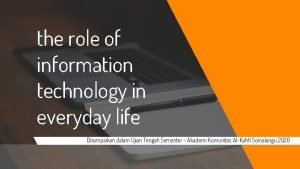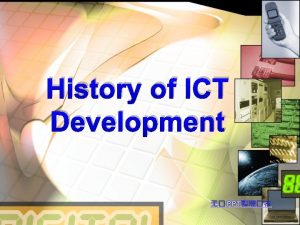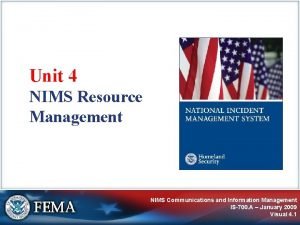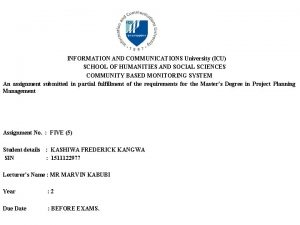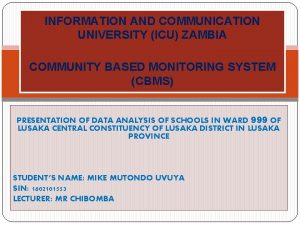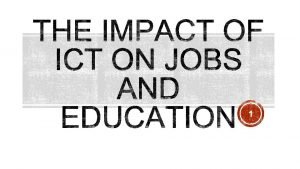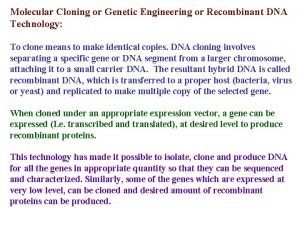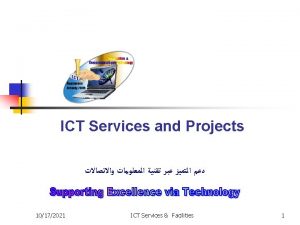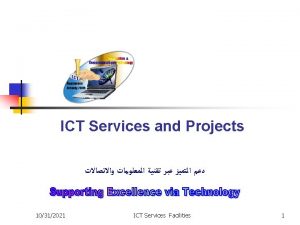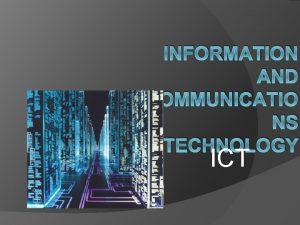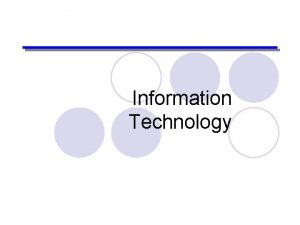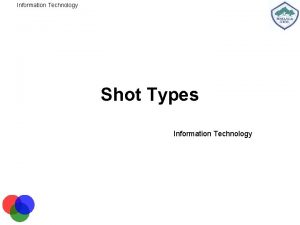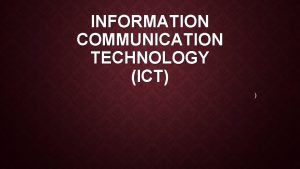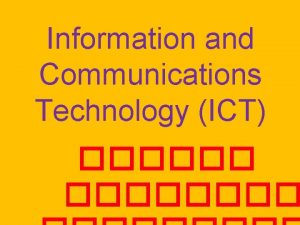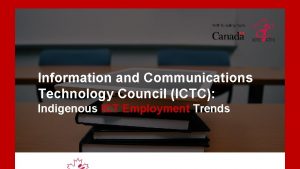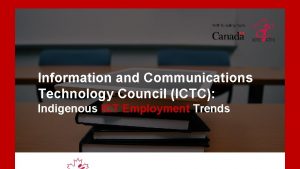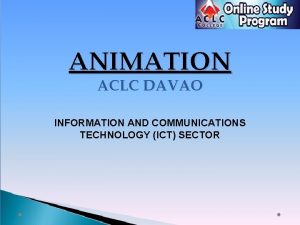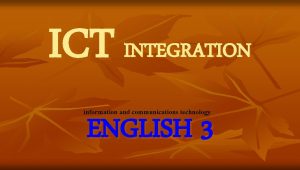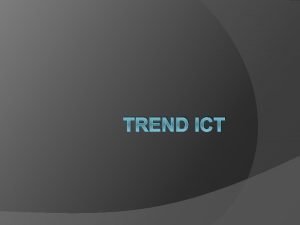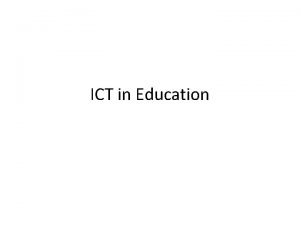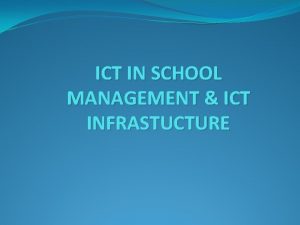Role of Information and Communications Technology ICT for




























































- Slides: 60

Role of Information and Communications Technology (ICT) for Multi Modal Transport Rajnish Kumar Professor IT, National Academy of Indian Railways pit@nair. railnet. gov. in

We will discuss • Existing applications for core operations • Technology Trend • Future of things

Historical Application of ICT Historically, the use of ICT in transport and logistics started in the 1960 s. Typical examples are inventory management systems, transport routing, scheduling, also known as Distribution Requirement Planning, and billing systems

Historical Application of ICT. . 2 Material Requirements Planning(MRP) and Manufacturing Resource Planning (MRP II) And then EMERGED Enterprise Resource Planning(ERP)

ENABLING TECHNOLOGIES Cloud Computing Wireless communication technologies (such as smart mobile phones, QR code, RFID and telematics tracking). Switching from dyadic one‐to‐one communication to simultaneous one‐to‐many communication changes the way supply chains are structured and information is shared

Proper categorisation of ICT functions REF: Giannopoulos (2004) Three functions are described below. Transportation resource management This function is related to the control of transportation resources such as load units, trucks, trains, ships and containers. Ports and terminals operations management: This function enables the control of the flow of material through the ports and terminals. Freight and vehicle tracking and tracing: This function enables the monitoring and control of the location of vehicles and freight in the transportation network.

“e. Freight” Present day problems Complexity of freight transport information exchange in the context of multimodal transport: Problems • lack of interoperability along the supply chain • operators provide information several times for different purposes • lack of information on intermodal availabilities Result inefficiencies, costs, reduced visibility of freight administrative costs + perceived complexity for multimodal transport no full exploitation of multimodal transport / nonoptimization of use of existing transport infrastructure Thus there is need for interoperable interfaces for information on freight in the various transport modes

“e. Freight”: The vision of EU • Interoperability between paperless freight information systems • Zero paper documents needed for planning, executing and completing any transport operation within the EU • Reduced waiting time at hubs related to administrative procedures • Standard framework for intermodal information exchange • Harmonised border crossings



Intelligent Transport Systems (ITS) ITS in the field of transport • Providing real-time traffic information, • Supporting traffic safety and transport operations etc. EXAMPLES of ITS in the field of transport: • Road intelligent transport systems (ITS), • Air traffic management system (SESAR), • European rail traffic management system (i. e. ERTMS) and rail information systems (i. e. TAF‐TSI), • Maritime surveillance systems (Safe. Sea. Net et al. ), VTMIS (Vessel Traffic Management and Information System and • Inland navigation (River Information Services [RIS]).

Barriers to Adoption of Technology REF: KOMODA, 2009. KOMODA: Co‐modality – Towards Optimised Integrated Chains in Freight Transport Logistics Deliverable D 3. 2: Action Plan. European Commission within the Seventh Framework Programme (2007– 2013).

Basic ICT IN INDIAN RAILWAYS

CENTRE FOR RAILWAY INFORMATION SYSTEMS (CRIS) • The Centre for Railway Information Systems (CRIS), an autonomous Society under the Ministry of Railways set up in 1986, plays the role of the Information Technology arm of the Indian Railways. • CRIS develops and maintains the major information systems deployed in the Railways, e. g. passenger ticketing, freight and passenger train operations, management of train crews, and management of fixed and rolling railway assets.

Freight/Operations Applications • Freight Operations Information System (FOIS), Terminal Management System (TMS) and E‐ Payment‐ About 2. 9 million tonnes of freight are booked daily in FOIS. • Nearly 1, 600 Railway Receipts (RRs), amounting to about Rs 255 crore, are generated, constituting 99. 9% of freight booked; approximately Rs 191 crore (75% of total) is collected through e‐ payment every day.

Freight/Operations Applications FOIS Rake Management System (RMS)‐ • About 4, 353 rakes are monitored daily through this module. Loads on the run / consignments in transit can be tracked by the customers on FOIS‐Web. • The Rake Allotment System provides optimum allocation of rakes for efficient freight movement.

Freight/Operations Applications. . contd • Control Office Application (COA) and Timetable Management System (Satsang)‐ About 5, 000 arrival/ departure events of 14000 trains are recorded each day in 77 control offices through COA. • Satsang assists in the preparation of train timetables to optimize running of trains.

Freight/Operations Applications. . contd • Crew Management System (CMS)‐ 362 lobbies are provided with CMS. • The system serves 47, 000 calls daily via SMS, enabling train crews to sign on and sign off at CMS kiosks.

Freight/Operations Applications. . contd Locomotive Management System (LMS for Diesel Locomotives) and SLAM (for Electric Locomotives) (Software for Locomotive Asset Management) These applications, presently implemented at a few sheds, will ultimately manage the maintenance of over 10, 000 locomotives Coaching/Freight Maintenance Management System (CMM/FMM) These applications, presently implemented at pilot locations, will manage the maintenance of 60, 000 coaching vehicles and 2, 50, 000 wagons.

Freight/Operations Applications. . advantages • These applications provide convenience and transparency for the Freight Customer. • They also ease the work of the Railway staff, improving overall efficiency. • Section controllers – reduced fatigue and stress through COA • Running staff – optimized crew rotation and automatic mileage calculation through CMS

Freight/Operations Applications. . advantages • Track maintenance staff – easier maintenance of records through Track Mgt System • Locomotive maintenance staff– information at fingertips through SLAM, LMS • Planners – Rake Allocation System of FOIS assists in optimal allotment of rakes

FOIS ‐ https: //www. fois. indianrail. gov. in/

Advances in interface technologies • The latest development of augmented reality(AR)technology • Augmented reality (AR) is a live direct or indirect view of a physical, real‐world environment whose elements are augmented (or supplemented) by computer‐generated sensory input such as sound, video, graphics or GPS data.

Policing Function


Application of Technology Examples from DHL • Vision Picking at DHL ‐ Augmented Reality in Logistics ‐ https: //www. youtube. com/watch? v=I 8 v. Yr. AUb 0 BQ • DHL Supply Chain's Service Logistics innovation‐ https: //www. youtube. com/watch? v=kb. Fbsa. Lm. Frw • http: //www. dhl. com/content/dam/downloads/g 0/about_us/logistics_insights/csi_ augmented_reality_report_290414. pdf • http: //www. dhl. com/content/dam/downloads/g 0/about_us/innovation/CSI_Studi e_BIG_DATA. pdf

Monitoring Mechanisms Some technologies like • RFID • NFC • QR Code

RFID • Radio-frequency identification (RFID) is the wireless non‐contact use of radio‐frequency electromagnetic fields to transfer data, for the purposes of automatically identifying and tracking tags attached to objects.

NFC • Near field communication (NFC) is a set of standards for Smartphone and similar devices to establish radio communication with each other by touching them together or bringing them into proximity, usually no more than a few centimetres. • List of applications of near field communication

QR Code The QR (Quick Response) Code is a two‐ dimensional (2‐D) matrix code that belongs to a larger set of machine‐ readable codes, all of which are often referred to as barcodes, regardless of whether they are made up of bars, squares or other‐shaped elements. http: //www. nacs. org/Link. Click. aspx? fileticket=D 1 Fp. VAvv. Juo%3 D&tabid=1426&mid=4802

Example of QR Code

The future

What is Io. T? • The Internet of Things (Io. T) has been defined by International Telecommunication Union in Recommendation ITU‐T Y. 2060 (06/2012) • The Io. T is a “network” of ‘things’ that can broadcast data and connect to the internet or to a network. • Objects, animals or people are given unique identifiers and the capability to transfer data over a network. • The convergence of wireless technologies, micro‐ electromechanical systems (MEMS) and the Internet leads to Io. T.

Potential of Io. T – Internet of Things • According to Gartner, by the 2020, there will be 26 billion devices connected to the internet, with 10 billion already connected. • Gartner further estimates that Io. T products and services will generate revenue exceeding $300 billion in 2020. IDC on the other hand has forecast that the worldwide market for Io. T solutions will grow to $7. 1 trillion in 2020.


REAL LIFE EXAMPLE OF IOT

302, shivalik complex, amikunj cross coads, naranpura, ahmedabad – 380013, gujarat , India infor@locanix. com ● www. locanix. com

Cold-Storage and Supply-Chain Management

Key Goals • • • Real‐time monitoring of Cold‐storages Regular Performance Feedback Business Integration Advanced Reporting Complete Supply Chain Management System under one single umbrella

Cold-Storage – Technology Specifications • Very Specialized Temperature Technology • Completely Digital Temperature sensing Technology • Measurable Temperature Range : ‐ 55°C ~ +125°C (‐ 67°F ~ +257°F) • Accuracy : ± 0. 5°C @ ‐ 10°C ~ +85°C • Maximum Resolution : 0. 0625°C • Very Stable Technology: Once installed, does not require any kind of maintenance or services

Cold-Storage - Technology Specifications • Real‐time Temperature Data Collection @ 1 minute interval. • Data‐logging can be done for more than 90 Days. • Daily Data Logs can be stored in separate Cold‐ storage wise folders and can be emailed respective supervisors and cold‐storage managers.

Cold-Storage - Security • Role‐based Access authorization for all cold‐ storages. Havmor Can see all Cold‐storages RSM Wise Acces Territory Wise Access

Cold-Storage - Real-Time View • Specialized View for monitoring of the Cold‐ storages. • You can see your complete supply‐chain cold‐ storages in singe view on the map.

Cold-Storage - Temperature Drop during Unloading • Cold‐storage systems can be integrated with Havmor Transportation System. • System Reports Average Temperature during Vehicle Unloading. • Based on that we can find “Temperature‐drop” factor during Vehicle Unloading. • Special report for UNLOADING EVENT can be designed which will show TEMPERATURE_AT_START, TEMPERATURE_AT_END and AVG_TEMPERATURE_DURING_UNLOADING

Cold-Storage - RSM and Supervisor Performance • It is also possible to find which Cold‐storage staff takes more time for UNLOADING and which Cold‐storage staff takes less time for unloading • Sometimes vehicle spend unnecessary time for unloading because of which the supply is affected. • Optimization on “Average‐Unloading‐Time” per vehicle can drive effective utilization of the Existing Resources

Cold-Storage - RSM and Supervisor Performance • Temperature Drop Event: As soon as the cold‐storage reaches and remains under thrash‐hold temperature drop condition, An event or alarm can be raised on the server. • Supervisors are immediately notified of any such event. • Most Importantly, A report is prepared every month automatically that shows how many times all cold‐storages have caused Temperature Drop conditions. • Havmor can find such Cold‐storages and take necessary actions.

Cold-Storage – Preventive Measures • If units are disconnected or Temperature sensor is disconnected inside the Cold‐ storage, an alert can be raised on the server with actual time of disconnect. • Supervisors are immediately notified of any such event.

Cold-Storage – Advanced Supply Chain Management • For Ex: This screen shows all vehicles in 300 Km. proximity of the ABU ROAD Cold‐storage.

Cold-Storage – Advanced Supply Chain Management Ø Locanix FMS operates out of enterprise grade cloud infrastructure Ø Reach out to your Cold‐storages from any internet connected device Ø No need to install any software anywhere

Cold-Storage – Endless Reporting Possibilities • Automatic report generation and delivery of Reports will significantly boost the productivity of your supply chain management staff and let them focus on more important matters at work then just downloading reports. • All reports automatically delivered to Email Inbox every day based on prescribed delivery schedule. • Excel, PDF, HTML, Graph Reports • “Sealed-Reports” – Once generated can not be altered or changed

Big Data Big data is a term for data sets that are so large or complex that traditional data processing applications are inadequate. Challenges include analysis, capture, data curation, search, sharing, storage, transfer, visualization, querying and information privacy.

Big Data … just a little bit more!!! 52

What is Analytics? Mathematical or Scientific methods that highlight data for insight Data is becoming the world’s new natural resource Insight = Competitive Advantage Used to inform actions and decisions With analytics, insights are created to augment the gut feelings and intuition for decisions

Big Data & Analytics A great example of Visualization Hans Rosling's 200 Countries, 200 Years, 4 Minutes ‐ The Joy of Stats ‐ BBC Four Link to Video https: //youtu. be/jbk. SRLYSojo

http: //www. blue‐yonder. com/blog‐e/wp‐content/uploads/2014/08/dhl_2. jpg http: //www. dhl. com/content/dam/downloads/g 0/about_us/innovation/CSI_Studie_BIG_DATA. pdf

Big Data Potential In addition to data fusion, there is process fusion —such as standardizing processes and understanding the various interlinked processes. This provides operations visibility across the entire process chain, which can improve all logistics‐ related functions, such as: • Distribution center sort optimization • Back‐haul activities • Revenue and fuel management



References • • • Irina Harris, Yingli Wang, Haiyang Wang, ICT in multimodal transport and technological trends: Unleashing potential for the future, International Journal of Production Economics, Volume 159, January 2015, Pages 88‐ 103, ISSN 0925‐ 5273, http: //dx. doi. org/10. 1016/j. ijpe. 2014. 09. 005. (http: //www. sciencedirect. com/science/article/pii/S 0925527314002837). BELOGIC EU project: http: //www. be‐logic. info/ e. Freight EU project: http: //www. efreightproject. eu/ European Commission (DG MOVE): ICT for transport logistics in the White Paper context, ECITL 2011 (14 October 2011, Thessaloniki). http: //www. railneteurope. com/tis_real‐time‐information. html RISING EU project: http: //www. rising. eu/web/guest; jsessionid=73 E 0 BFE 8488 F 7 FF 97 C 2 A 0 D 7334 FBFAE 3 SONORA EU project: http: //www. sonoraproject. eu/ WHITE PAPER Roadmap to a Single European Transport Area – Towards a competitive and resource efficient transport system, Brussels, 28. 3. 2011, COM(2011) 144 final Telematic Applications for Freight ‐ Technical Specification for Interoperability (TAF – TSI) http: //www. worldbank. org/en/news/feature/2015/05/14/informationandcommunicationte chnologiesfacilitatetheevolutionoftransportsystems

Discussion
 Role of information technology in our daily life
Role of information technology in our daily life History of ict
History of ict Track and report nims
Track and report nims Information and communications university
Information and communications university Information and communication university zambia location
Information and communication university zambia location Azure worker role
Azure worker role What is information
What is information Rollenmodell
Rollenmodell Statuses and their related roles determine the structure
Statuses and their related roles determine the structure Role of alkaline phosphatase in recombinant dna technology
Role of alkaline phosphatase in recombinant dna technology Fspos
Fspos Typiska drag för en novell
Typiska drag för en novell Tack för att ni lyssnade bild
Tack för att ni lyssnade bild Returpilarna
Returpilarna Varför kallas perioden 1918-1939 för mellankrigstiden
Varför kallas perioden 1918-1939 för mellankrigstiden En lathund för arbete med kontinuitetshantering
En lathund för arbete med kontinuitetshantering Underlag för särskild löneskatt på pensionskostnader
Underlag för särskild löneskatt på pensionskostnader Tidbok för yrkesförare
Tidbok för yrkesförare Sura för anatom
Sura för anatom Vad är densitet
Vad är densitet Datorkunskap för nybörjare
Datorkunskap för nybörjare Tack för att ni lyssnade bild
Tack för att ni lyssnade bild Tes debattartikel
Tes debattartikel Delegerande ledarskap
Delegerande ledarskap Nyckelkompetenser för livslångt lärande
Nyckelkompetenser för livslångt lärande Påbyggnader för flakfordon
Påbyggnader för flakfordon Tryck formel
Tryck formel Offentlig förvaltning
Offentlig förvaltning Bo bergman jag fryser om dina händer
Bo bergman jag fryser om dina händer Presentera för publik crossboss
Presentera för publik crossboss Argument för teckenspråk som minoritetsspråk
Argument för teckenspråk som minoritetsspråk Vem räknas som jude
Vem räknas som jude Klassificeringsstruktur för kommunala verksamheter
Klassificeringsstruktur för kommunala verksamheter Epiteltyper
Epiteltyper Bästa kameran för astrofoto
Bästa kameran för astrofoto Cks
Cks Programskede byggprocessen
Programskede byggprocessen Bra mat för unga idrottare
Bra mat för unga idrottare Verktyg för automatisering av utbetalningar
Verktyg för automatisering av utbetalningar Rutin för avvikelsehantering
Rutin för avvikelsehantering Smärtskolan kunskap för livet
Smärtskolan kunskap för livet Ministerstyre för och nackdelar
Ministerstyre för och nackdelar Tack för att ni har lyssnat
Tack för att ni har lyssnat Mall för referat
Mall för referat Redogör för vad psykologi är
Redogör för vad psykologi är Stål för stötfångarsystem
Stål för stötfångarsystem Atmosfr
Atmosfr Borra hål för knoppar
Borra hål för knoppar Vilken grundregel finns det för tronföljden i sverige?
Vilken grundregel finns det för tronföljden i sverige? Fr formel
Fr formel Tack för att ni har lyssnat
Tack för att ni har lyssnat Steg för steg rita
Steg för steg rita Vad är verksamhetsanalys
Vad är verksamhetsanalys Tobinskatten för och nackdelar
Tobinskatten för och nackdelar Toppslätskivling dos
Toppslätskivling dos Mästar lärling modellen
Mästar lärling modellen Egg för emanuel
Egg för emanuel Elektronik för barn
Elektronik för barn Antikt plagg
Antikt plagg Strategi för svensk viltförvaltning
Strategi för svensk viltförvaltning Kung som dog 1611
Kung som dog 1611
